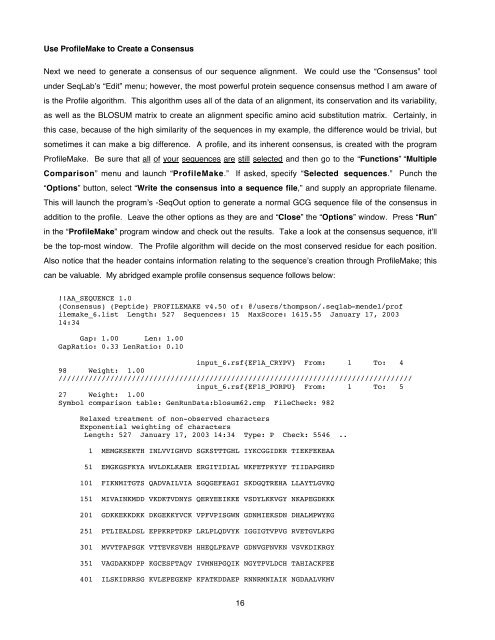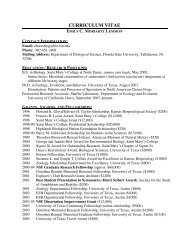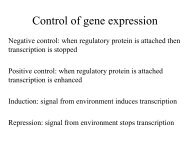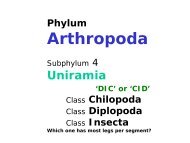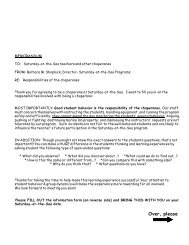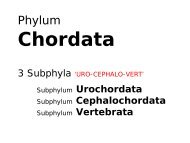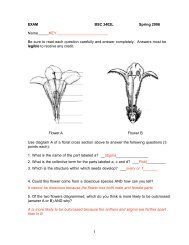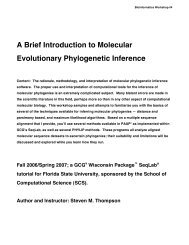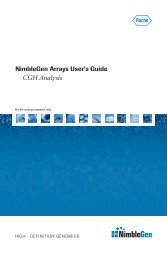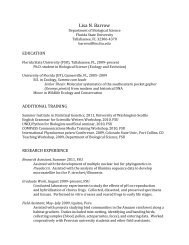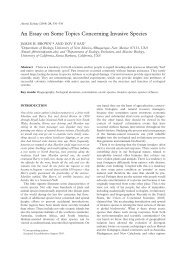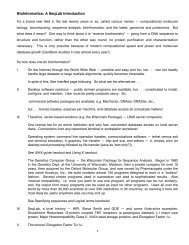Unknown DNA â Rational Primer Design and Analysis â the ...
Unknown DNA â Rational Primer Design and Analysis â the ...
Unknown DNA â Rational Primer Design and Analysis â the ...
Create successful ePaper yourself
Turn your PDF publications into a flip-book with our unique Google optimized e-Paper software.
Use ProfileMake to Create a Consensus<br />
Next we need to generate a consensus of our sequence alignment. We could use <strong>the</strong> “Consensus” tool<br />
under SeqLab’s “Edit” menu; however, <strong>the</strong> most powerful protein sequence consensus method I am aware of<br />
is <strong>the</strong> Profile algorithm. This algorithm uses all of <strong>the</strong> data of an alignment, its conservation <strong>and</strong> its variability,<br />
as well as <strong>the</strong> BLOSUM matrix to create an alignment specific amino acid substitution matrix. Certainly, in<br />
this case, because of <strong>the</strong> high similarity of <strong>the</strong> sequences in my example, <strong>the</strong> difference would be trivial, but<br />
sometimes it can make a big difference. A profile, <strong>and</strong> its inherent consensus, is created with <strong>the</strong> program<br />
ProfileMake. Be sure that all of your sequences are still selected <strong>and</strong> <strong>the</strong>n go to <strong>the</strong> “Functions” “Multiple<br />
Comparison” menu <strong>and</strong> launch “ProfileMake.” If asked, specify “Selected sequences.” Punch <strong>the</strong><br />
“Options” button, select “Write <strong>the</strong> consensus into a sequence file,” <strong>and</strong> supply an appropriate filename.<br />
This will launch <strong>the</strong> program’s -SeqOut option to generate a normal GCG sequence file of <strong>the</strong> consensus in<br />
addition to <strong>the</strong> profile. Leave <strong>the</strong> o<strong>the</strong>r options as <strong>the</strong>y are <strong>and</strong> “Close” <strong>the</strong> “Options” window. Press “Run”<br />
in <strong>the</strong> “ProfileMake” program window <strong>and</strong> check out <strong>the</strong> results. Take a look at <strong>the</strong> consensus sequence, it’ll<br />
be <strong>the</strong> top-most window. The Profile algorithm will decide on <strong>the</strong> most conserved residue for each position.<br />
Also notice that <strong>the</strong> header contains information relating to <strong>the</strong> sequence’s creation through ProfileMake; this<br />
can be valuable. My abridged example profile consensus sequence follows below:<br />
!!AA_SEQUENCE 1.0<br />
(Consensus) (Peptide) PROFILEMAKE v4.50 of: @/users/thompson/.seqlab-mendel/prof<br />
ilemake_6.list Length: 527 Sequences: 15 MaxScore: 1615.55 January 17, 2003<br />
14:34<br />
Gap: 1.00 Len: 1.00<br />
GapRatio: 0.33 LenRatio: 0.10<br />
input_6.rsf{EF1A_CRYPV} From: 1 To: 4<br />
98 Weight: 1.00<br />
//////////////////////////////////////////////////////////////////////////////////<br />
input_6.rsf{EF1S_PORPU} From: 1 To: 5<br />
27 Weight: 1.00<br />
Symbol comparison table: GenRunData:blosum62.cmp FileCheck: 982<br />
Relaxed treatment of non-observed characters<br />
Exponential weighting of characters<br />
Length: 527 January 17, 2003 14:34 Type: P Check: 5546 ..<br />
1 MEMGKSEKTH INLVVIGHVD SGKSTTTGHL IYKCGGIDKR TIEKFEKEAA<br />
51 EMGKGSFKYA WVLDKLKAER ERGITIDIAL WKFETPKYYF TIIDAPGHRD<br />
101 FIKNMITGTS QADVAILVIA SGQGEFEAGI SKDGQTREHA LLAYTLGVKQ<br />
151 MIVAINKMDD VKDKTVDNYS QERYEEIKKE VSDYLKKVGY NKAPEGDKKK<br />
201 GDKKEKKDKK DKGEKKYVCK VPFVPISGWN GDNMIEKSDN DHALMPWYKG<br />
251 PTLIEALDSL EPPKRPTDKP LRLPLQDVYK IGGIGTVPVG RVETGVLKPG<br />
301 MVVTFAPSGK VTTEVKSVEM HHEQLPEAVP GDNVGFNVKN VSVKDIKRGY<br />
351 VAGDAKNDPP KGCESFTAQV IVMNHPGQIK NGYTPVLDCH TAHIACKFEE<br />
401 ILSKIDRRSG KVLEPEGENP KFATKDDAEP RNNRMNIAIK NGDAALVKMV<br />
16


